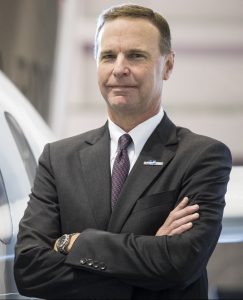
I am often asked about what I think the future holds for the global business aviation industry. More than ever before, I’m excited by several emerging and growing trends in our community, as we see an unprecedented level of innovation and excitement driving us forward to a bright and promising future. Our industry is not only embracing change, but helping foster numerous advancements in areas such as supersonic transport, electronic propulsion and autonomous flight.
Over the past few years, a new transportation segment has emerged alongside more traditional business aircraft and rotorcraft seen at National Business Aviation Association (NBAA) events. Urban air mobility (UAM) aims to revolutionize travel across large metroplexes, utilizing optionally piloted and even fully autonomous electric vertical takeoff and landing (eVTOL) vehicles to transport on-demand passengers and cargo.
From Science Fiction to Real Life
This may seem within the realm of science fiction, but anyone who’s ever dreamed of traveling above congested city streets may soon have their dreams realized, possibly much sooner than they may think. Earlier this year, the 2019 Uber Elevate Summit in Washington, D.C. featured a slew of eVTOL designs, not only from emerging players in this market, but from established aircraft manufacturers, including Bell, Embraer, Boeing and Airbus. Many of these efforts were also apparent throughout the recently concluded 2019 NBAA Business Aviation Convention & Exhibition.
The show displayed new modes of transport, including UAM vehicles and unmanned aircraft systems (UAS), and included several education sessions focused on both the promise and challenges of implementing UAM, including the need for an advanced air traffic control infrastructure able to safely integrate UAM across urban airspace.
These hybrids gas-electric and, ultimately, fully electric designs offer the promise of safe and efficient travel within metropolitan areas around the globe and even to the airport for longer-distance trips. NBAA also expects these designs to ultimately complement traditional business aviation aircraft that are also moving toward more efficient operations and reducing our industry’s already-low carbon footprint.
Sustainability is Key to Industry’s Future
Certainly, the issue of environmental sustainability is a dominant theme not only in headlines, but also in the boardrooms and flight departments of companies using business aviation to improve their efficiency and competitiveness. However, it’s important to note these companies – along with aircraft and engine manufacturers, fuel providers and other stakeholders – have long sought to improve their own environmental footprint and the efficiency of their products and operations.
The industry’s commitment to sustainability became official more than 10 years ago, when business aircraft operators represented by the International Business Aviation Council joined with aircraft manufacturers and service providers to launch the “Business Aviation Commitment on Climate Change,” an aggressive program to continually reduce the industry’s carbon footprint.
One of the most promising avenues toward fulfilling that commitment with today’s business aircraft is through the use of sustainable aviation fuels (SAF) derived from renewable feed stocks that can reduce aviation’s carbon lifecycle emissions by up to 80%. Our industry’s united support for SAF was first codified last year, as a coalition of international business aviation organizations joined government officials in Geneva to redouble their focus on advancing the development and adoption of SAF.
At the heart of this initiative is the Business Aviation Guide to the Use of Sustainable Aviation Fuels (SAF), a resource focused on raising awareness that such fuels for business aviation are safe, approved and available now; that SAF offer myriad benefits, including those in support of the sustainability of business aviation, corporate responsibility and reduced emissions; and that such fuels are derived from several sustainable, renewable resources and are therefore an environmental “win-win.”
With the Guide spurring industrywide interest in sustainable aviation fuels, the next step in raising awareness and promoting education of its benefits came in January 2019, when IBAC joined with a coalition of other industry groups to sponsor the first-ever SAF demonstration day at Van Nuys Airport (VNY) in Southern California to prove the fuels’ viability and safety.
Officials Support Industry Efforts
During the daylong event, VNY’s four fixed-based operators fueled aircraft throughout the day with SAF from suppliers World Fuel Services and Avfuel. Local officials expressed their support for this industry-wide, all-voluntary, private investment in research and innovation, and numerous demonstration flights were conducted by business aircraft powered by SAF.
The demonstration at Van Nuys paved the way for the first European SAF demonstration in May 2019, held at Tag Farnborough London Airport in England ahead of EBACE2019. Aircraft from Bombardier, Gulfstream, Cirrus, Embraer, Piaggio, Dassault and Textron Aviation fueled up on sustainable alternative fuels at Farnborough and other airports throughout Europe and the U.S. for exhibition flights showcasing the viability of SAF.
These efforts culminated at 2019 NBAA-BACE with around two dozen aircraft fueling with SAF enroute to the show. Local civic and business leaders issued a proclamation recognizing the business aviation community’s long-standing commitment to sustainability, with an estimated 150,000 gallons of SAF pumped into aircraft at Henderson Airport.
It is evident that our industry is embracing change across several fronts, and I expect this energy and inspiration to carry forward to our upcoming events in the next year, including the 2020 edition of NBAA-BACE.
Whether your flight department is based in Las Vegas or Geneva, Stockholm or Shanghai, it’s clear our global business aviation community is in the midst of an unprecedented and thrilling transformation before our eyes, as new aircraft, technologies and practices take hold, showcasing the innovation and environmental sustainability of our industry.